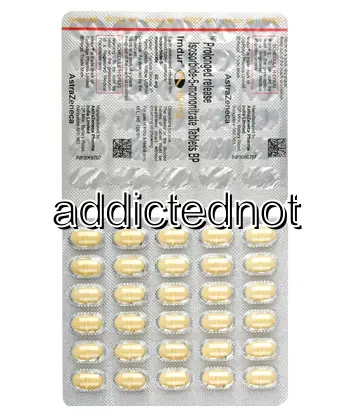| Package | Dosage | Price | Price per Dose | |
|---|---|---|---|---|
| Dosage: 20mg | ||||
| 360 pill | 20mg | $407.51 | $1.13 | |
| 180 pill | 20mg | $224.89 | $1.25 | |
| 120 pill | 20mg | $165.70 | $1.39 | |
| 90 pill | 20mg | $138.65 | $1.54 | |
| 60 pill | 20mg | $103.13 | $1.72 | |
| 30 pill | 20mg | $64.24 | $2.15 | |
| Dosage: 30mg | ||||
| 360 pill | 30mg | $529.27 | $1.47 | |
| 180 pill | 30mg | $285.76 | $1.59 | |
| 120 pill | 30mg | $213.05 | $1.78 | |
| 90 pill | 30mg | $177.54 | $1.98 | |
| 60 pill | 30mg | $131.88 | $2.20 | |
| 30 pill | 30mg | $82.84 | $2.76 | |
| Dosage: 40mg | ||||
| 240 pill | 40mg | $377.08 | $1.57 | |
| 120 pill | 40mg | $206.29 | $1.72 | |
| 90 pill | 40mg | $180.92 | $2.01 | |
| 60 pill | 40mg | $138.65 | $2.32 | |
| 30 pill | 40mg | $77.77 | $2.59 | |
| Dosage: 60mg | ||||
| 180 pill | 60mg | $404.13 | $2.25 | |
| 120 pill | 60mg | $292.53 | $2.44 | |
| 90 pill | 60mg | $235.03 | $2.60 | |
| 60 pill | 60mg | $169.08 | $2.82 | |
| 30 pill | 60mg | $98.06 | $3.28 | |

Imdur Description
Overview of Imdur
Imdur is a medication commonly prescribed in the United States for the prevention and management of angina pectoris, a condition characterized by chest pain due to reduced blood flow to the heart. The active ingredient in Imdur isisosorbide mononitrate, a nitrate that helps relax and widen blood vessels. This medication is known for its long-acting properties, making it suitable for daily use to prevent anginal attacks rather than treat acute episodes. Many patients appreciate its ease of use and the consistency it offers in managing symptoms.
How Imdur Works
Once ingested, Imdur releases isosorbide mononitrate, which works by relaxing the smooth muscles within blood vessel walls. This relaxation leads to vasodilation, or the widening of blood vessels, which reduces the workload of the heart and increases blood flow to the heart muscle. As a result, patients often experience fewer episodes of chest pain. Imdur's long-acting formulation allows for sustained blood vessel dilation, helping to maintain stable blood flow throughout the day. In the United States, doctors often recommend Imdur as part of a comprehensive treatment plan for angina, alongside lifestyle modifications and other medications.
Patient Reviews and Experiences
Many users in the USA report that Imdur effectively reduces the frequency and severity of angina attacks. Patients appreciate that they can often take the medication once daily, which fits conveniently into their routines. Some notice an improvement within a few days of starting treatment, though full benefits may take longer. Commonly mentioned side effects include headaches, dizziness, and flushing. These are usually transient and tend to diminish over time.
It’s important for users to communicate with their healthcare provider about any persistent or severe side effects. Some patients also mention feeling more tired or experiencing a slight drop in blood pressure, so monitoring is advised. Several reviews highlight the importance of adhering to the prescribed dose to avoid tolerance or side effects. Overall, Imdur is viewed positively among many in the US due to its role in enabling a more active lifestyle by managing anginal symptoms effectively.
Precautions and Considerations
While Imdur is generally safe when used as directed, there are essential precautions. Patients should inform their healthcare provider of any other medications they are taking, especially other blood pressure medications, erectile dysfunction drugs, or medications that may interact negatively with nitrates. Persons with low blood pressure, anemia, or increased intracranial pressure should use Imdur cautiously. It’s also crucial not to abruptly stop taking Imdur without medical guidance because sudden cessation can lead to a rebound of symptoms.
In the United States, physicians often check blood pressure regularly during therapy to ensure safety and effectiveness. Patients are advised to take the medication exactly as prescribed, usually with a full glass of water, and to avoid alcohol, which can exacerbate side effects. Proper use and communication with healthcare providers help maximize benefits while minimizing risks.